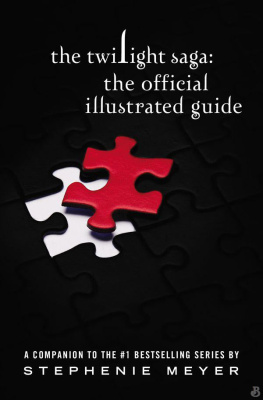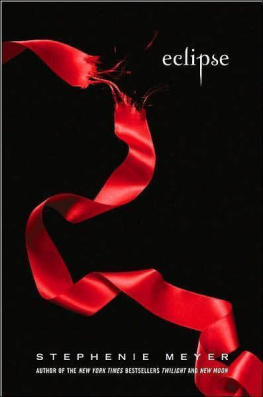

RELIGIOUS THEMES in the Twilight SAGA
SANDRA L. GRAVETT

Copyright 2010 by Sandra L. Gravett.
All rights reserved. For permission to reuse content, please contact Copyright Clearance Center, 222 Rosewood Drive, Danvers, MA 01923, (978) 750-8400, www.copyright.com.
Bible quotations, unless otherwise marked, are from the New Revised Standard Version Bible, copyright 1989, Division of Christian Education of the National Council of the Churches of Christ in the United States of America. Used by permission. All rights reserved.
Bible quotation marked KJV is from the King James Version of the Bible.
Cover art: iStockphoto
Cover and interior design: Elizabeth Wright
Visit Chalice Press on the World Wide Web at
www.chalicepress.com
10 9 8 7 6 5 4 3 2 1 | 10 11 12 13 14 15 |
EPUB: 978-08272-10486 EPDF: 978-08272-10493
Library of Congress Cataloging-in-Publication Data
Gravett, Sandra L.
From Twilight to Breaking dawn : religious themes in the Twilight saga / by Sandie Gravett.
p. cm.
Includes bibliographical references.
ISBN 978-0-8272-1047-9
1.Meyer, Stephenie, 1973- Twilight saga series. 2. Meyer, Stephenie, 1973Religion. 3. Christianity in literature. I. Title.
PS3613.E979Z66 2010
813'.6dc22
2010008559
Printed in the United States of America
C ontents
R evelation, the F inal A pocalypse, and the
C oming of the K ingdom
Preface
Getting the flu, especially in the summer, generally never ends up to be a cause for thanks. In my case, however, I took to bed in May 2009 with Stephenie Meyers Twilight out of curiosity over the big fuss. I read it in one afternoon and continued on subsequent days of not feeling well with New Moon, Eclipse, and Breaking Dawn. Then I watched the movie version of Twilight and found the online version of Midnight Sun.
The ideas about how the books and films played on religious themes and used religious images kept coming. But the real prod to write about it came after talking to people about their reactions to the series. I guess I had been hiding under a rock, as I had not realized just how invested people were in this story. Everywhere I went I met somebody who loved these books and, for many of them, I met a daughter or a granddaughter who shared the passion.
When I presented my work about these books on the Appalachian State University campus in September 2009, I found students also strongly connected to this world. A number of dedicated Christians shared with me how they understood these books as stories of faith, love, and sacrifice in the best of their traditions. I could have written an entirely different volume based solely on how they read these novels.
I completed this manuscript just as New Moon arrived in theaters and got to add a little from my viewing of the film. Part of me would like to wait and see Eclipse next summer before going to print, but I know that the movies merely add a few touches, and I am working more with the content of the books.
It has been quite a fun but busy time writing this book. I have been encouraged and supported by many, but would like to thank my parents, sister, and Parker Williams, Lisa Lanier, and Les Gura in particular.
Introduction
Stephenie Meyers Twilight saga ( Twilight, 10/2005; New Moon, 9/2006; Eclipse, 8/2007; Breaking Dawn, 8/2008) took the young adult fiction world by storm. With more than 95 million copies sold worldwide, Meyer topped the list of best sellers in 2008, occupying all four of the top spots for the first time ever. The first quarter of 2009 continued her run with one of every seven books sold belonging to this series. Additionally, Twilight, the first of four movies, came out in November 2008 and grossed over $384 million in worldwide box office and generated $151 million in DVD sales with over 8 million units sold in 2009. The second film, New Moon, premiered in November 2009 and broke the midnight box office records for Friday screenings at $26.3 million on the way to a record $72.7 million dollars in first-day ticket sales and the third largest opening weekend ever at $140.7 million. The story of a young woman, Bella Swan, and her love affair with the eternally seventeen-year old vampire Edward Cullen further prompted an entire cottage industry of products, Web sites, and parties, and even resulted in record sales of clothing items worn in the movie. The Twilight soundtrack sold 3.5 million copies, and New Moon, released early because of online leaks, debuted as the number one album.
These books introduce a variety of topics from young love, to abstinence, to the value of family and friends. But the author, a devout Mormon, also infuses her stories with religious themes and images. Although by no means dominant, or even particularly overt, Meyers use of religion provides for some intriguing interpretive possibilities. Biblical figures such as Christ, Eve, and Mary function as prototypes for her characters. The relationship between free will and determinism, as well as the importance of moral agency, threads thematically through all four volumes. Images of the garden and the peaceable kingdom provide frames for her story. Love as an agent of change and a motivational impulse for self-sacrifice also receives significant emphasis.
This examination of the intersection of religious themes and images and the novels/movie begins with a short synopsis of each narrative to situate the reader. It then proceeds in separate chapters to explore the two major characters, Edward and Bella, with a focus on Edward as a Christ-figure and the use of an Eve/Mary pattern for Bella. Subsequent chapters will explore Carlisles family history and its relationship to his role as father and a God figure, the necessity of moral choice, Renesmee as a type of Christ child, the similarities of the final battle with the Volturi to Johns Apocalypse, and the human, vampire, and shape-shifter communities forged in the model of the kingdom of God.
The Story
Narrated by the central character, Bella Swan, Twilight tells the story of her move from Phoenix, Arizona, to the town of Forks, Washington, to live with Charlie, her father and the sheriff. At her new school, she encounters a mysterious and beautiful family, the Cullens, and feels a particular draw toward seventeen-year-old Edward. She puzzles over his intense reaction to her, and he gradually becomes her protector by saving her from a series of dangers, including being crushed by an out of control van and an attack by four men on a dark street. As their relationship develops, Bella discovers his true identity as a vampire. Despite the fact that his family feeds on the blood of animals as a matter of conscience, Edward struggles to rein in his desire to kill Bella, first out of fear of exposing his family as vampires and then because of his love for her.
The complications of love between a vampire and human play out in a variety of ways. Bellas fragility in the face of Edwards physical power generates her desire to be more like him in order to secure the possibility of a future together. This theme plays out most strongly as three vampires passing through the regionLaurent, Victoria, and Jamesthreaten her life. In particular, James inflicts significant harm, including a bite that could be the start of her transformation. Edward saves Bellas human life first by stopping James from killing her and then by preventing the change from occurring; Edwards love for her allows him to suck the vampire venom from her blood even as such action threatens to snap his control over his nature. They end the novel together, happy, and at the school prom.











